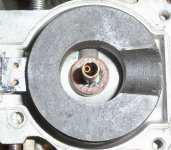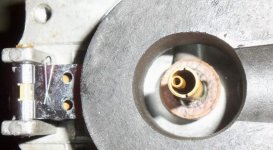Keithm18
Regular Contributor
Hi All. Merry Christmas.
i need your kind assistance again please.
on my last two outings my motor has started to give me grief at low speeds as follows;
When going at WOT the engine runs fine with no missing or stutters. However whenever I come to shore, shut the engine off and then startup and leave shore the problem shows up.
The motor starts on the first try, quickly and will idle all day, i can cruise in gear to exit of the no wake zone, but when I then go to WOT the engine seems to "bog" and die. This seems to happen when the motor is warm or cold.
When this happens I can easily start the motor and it will idle fine, but stalls again when I try to go to half or full throttle. To fix the problem I have to use the warm up lever and rev the motor for a few second in neutral, before quickly slamming it into gear and then sometimes it takes off or I have to repeat a few times before getting under way.
If I'm towing and come to a stop and shut the motor off and then quickly go from start to wot the problem does not present itself and once under way there are no other problems.
I'm using the recommended NGK plugs, as I cannot find champions in my area and the carbs were rebuilt about three months ago. The fuel is new and I am pre mixing 50:1. The thermostats were recently replaced and the water pump etc is all working 100%
the motor is an 81 v4 Johnson j90mlcim
I suspect that the plugs may be fouling at trawling speeds as the engine may be running too cool or that the linkage between the timing and carbs needs adjusting. does anyone have any ideas for me please?
thanks as always.
i need your kind assistance again please.
on my last two outings my motor has started to give me grief at low speeds as follows;
When going at WOT the engine runs fine with no missing or stutters. However whenever I come to shore, shut the engine off and then startup and leave shore the problem shows up.
The motor starts on the first try, quickly and will idle all day, i can cruise in gear to exit of the no wake zone, but when I then go to WOT the engine seems to "bog" and die. This seems to happen when the motor is warm or cold.
When this happens I can easily start the motor and it will idle fine, but stalls again when I try to go to half or full throttle. To fix the problem I have to use the warm up lever and rev the motor for a few second in neutral, before quickly slamming it into gear and then sometimes it takes off or I have to repeat a few times before getting under way.
If I'm towing and come to a stop and shut the motor off and then quickly go from start to wot the problem does not present itself and once under way there are no other problems.
I'm using the recommended NGK plugs, as I cannot find champions in my area and the carbs were rebuilt about three months ago. The fuel is new and I am pre mixing 50:1. The thermostats were recently replaced and the water pump etc is all working 100%
the motor is an 81 v4 Johnson j90mlcim
I suspect that the plugs may be fouling at trawling speeds as the engine may be running too cool or that the linkage between the timing and carbs needs adjusting. does anyone have any ideas for me please?
thanks as always.



